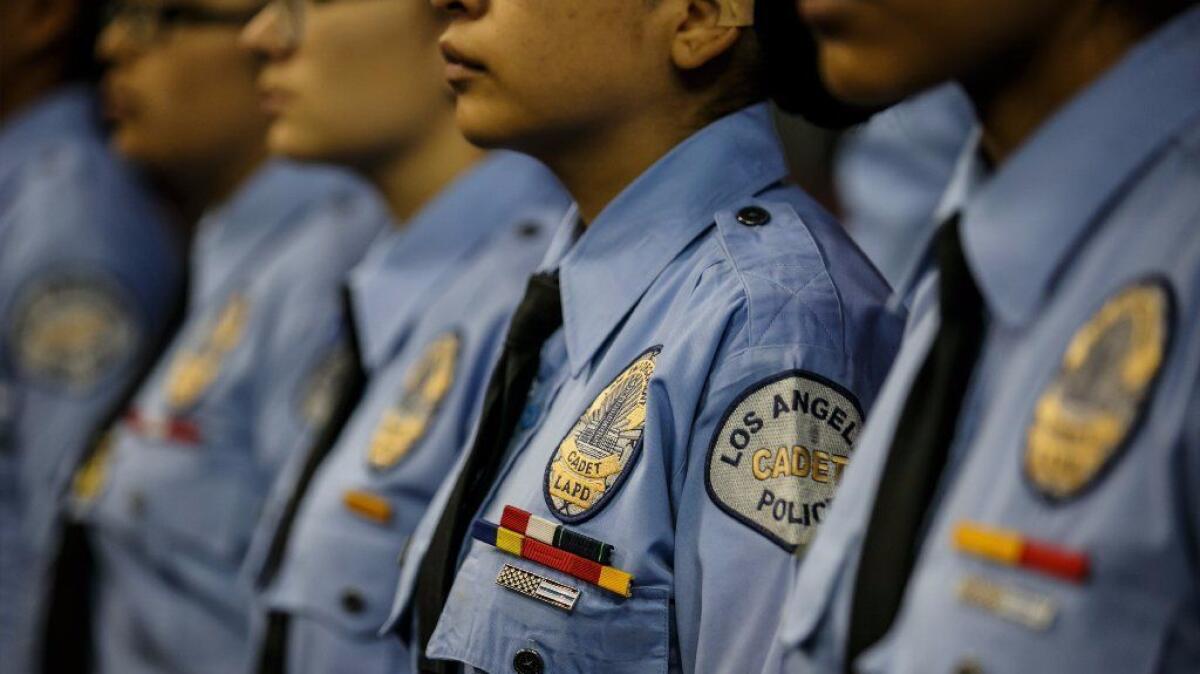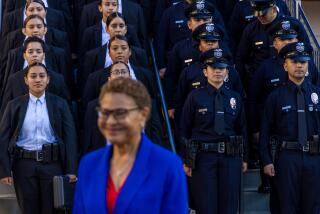LAPD review of cadet scandal finds inadequate supervision, other deficiencies

- Share via
At some police stations, a single officer supervised 60 teenage cadets.
Cadets occasionally used social media to bully one another or express “infatuations” with police officers. They sometimes logged into police computers using an officer’s serial number.
Officers who worked with cadets received no formal training in how to interact with young people.
These were among the deficiencies enumerated in an internal review of the Los Angeles Police Department’s cadet program, which is reeling from a scandal involving stolen police cruisers and alleged abusive sexual contact between a police officer and a 15-year-old cadet.
On Friday, LAPD officials released the 26-page review and an updated manual for the department’s youth programs.
The new manual addresses some flaws in the previous document, which was last revised more than a decade ago, did not include rules about social media and repeatedly referenced the long-defunct Explorer program.
On June 14, three cadets in stolen police cars led LAPD officers on a chase through the streets of Los Angeles. Four other cadets were arrested on suspicion of stealing Tasers, bulletproof vests and other equipment.
The relationship between the police officer, Robert Cain, and the 15-year-old female cadet developed in part through text messages, Chief Charlie Beck has said.
Cain, 31, was assigned to the equipment room at 77th Street Station, where most of the seven cadets were based. The cadet programs at 77th Street and Pacific stations have been suspended.
Cain was charged July 20 with two counts each of oral copulation of a person under the age of 16, lewd acts upon a child and unlawful sexual intercourse, according to the Los Angeles County district attorney’s office.
LAPD officials are continuing an internal investigation of the cadet scandal, which has cast a cloud over a program that enrolls more than 2,000 young people ages 13 to 20.
At a news conference Friday, Beck said the investigation is in “the seventh inning,” with Cain the only police officer suspected of wrongdoing. Criminal charges have not been filed against the seven cadets, most of whom are juveniles.
The review notes that the cadet program is designed to build character and leadership skills and to improve relationships between the police and residents. Its reach is broad, with recruiting efforts targeting not just model students but also those who are “needy, disadvantaged and isolated.” Most cadets do not aspire to become police officers.
Beck said the number of cadets has tripled in recent years, which has led to some of the problems described in the review.
He emphasized that city officials continue to support the program.
Beck voiced his faith in “not only the efficacy but the value of this to the city of Los Angeles and the young people of Los Angeles.”
Some of the cadets checked out a police car in the name of a sergeant and kept the vehicle for up to 10 days, putting a “lot of miles” on it, Beck said.
A citywide inventory of police equipment has turned up no missing vehicles or firearms. A review of technology and procedures at station equipment rooms, or kit rooms, is under way.
The police officers who supervise cadets are known as youth services officers. They are assigned to the cadet program full time but are sometimes called away to help with other jobs, such staffing front desks, the review said.
The officers did not receive formal training on how to interact with minors, making it difficult to hold them accountable if a problem arose, said an executive summary attached to the review.
Recently, though, the youth services officers attended a mandatory training session. They will be issued department cellphones so their communications with cadets can be monitored, Beck said.
The revised manual states that youth services officers should not be routinely assigned other duties. It provides guidelines for staffing ratios, including one adult for 35 youths in a classroom setting and one adult for 30 youths during physical fitness training.
Mirroring a directive that Beck issued after the cadet scandal exploded, the manual restricts one-on-one contact between cadets and adults and limits text and social media messages to necessary business.
The manual prohibits cadets from using department computers, driving police vehicles or setting foot in kit rooms.
Cadets typically do not do police work, though at some stations, they answer questions at the front desk. The revised manual permits them to answer phones and fill out simple police reports. The new guidelines also allow cadets older than 18 to participate in vice investigations.
For more news on the Los Angeles Police Department, follow me on Twitter: @cindychangLA
Twitter: @katemather
UPDATES:
6:25 p.m.: This article was updated with additional details from the news conference and comments from LAPD Chief Charlie Beck.
This article was originally published at 12:35 p.m.
More to Read
Sign up for Essential California
The most important California stories and recommendations in your inbox every morning.
You may occasionally receive promotional content from the Los Angeles Times.















